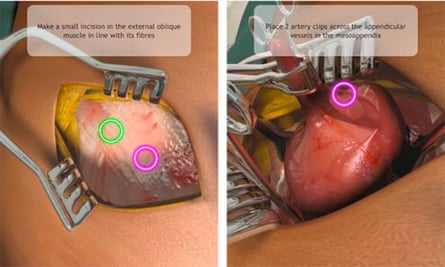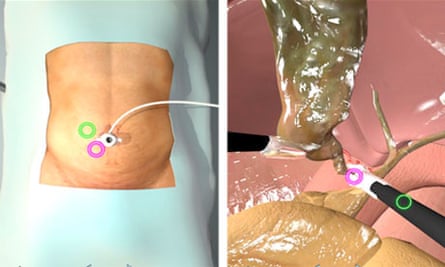With an effortless swipe of the finger, you slice open the patient's skin. A gentle pinch and the flesh is prised apart to reveal layers of tissue. Another swipe and a pair of scissors descends into view and begins to cut into the muscle. A few more swipes, taps and pinches and, hey presto, you've removed an appendix.
This is Touch Surgery, a new iPhone and iPad app designed to help trainee surgeons learn the steps of their operations. Described as a "mobile surgical simulator", it is not to be confused with the fun-for-all-the-family game Operation. Remember the nervous thrill of trying to remove a miniature plastic rib with a pair of tweezers without setting the buzzer off? Well, Touch Surgery takes it to a whole new level: every step of each procedure is animated in graphic 3D detail. It's not for the squeamish.
"We came up with the idea in response to the problem of surgeons' hours being cut," says Jean Nehme, who developed the project with fellow surgeons Andre Chow, Sanjay Purkayastha and Advait Gandhe, a consultant orthopaedic surgeon with a knack for digital modelling, who conceived the original digital surgical simulator in his spare time. "The European working time directive has cut doctors' hours from around 100 a week to 40, meaning trainee surgeons can't get the valuable experience they need."
The app will help to fill the gap, says Nehme, but it is also designed to improve patient safety, giving surgeons more confidence and providing a means of safe training and assessment before a blade ever reaches a body.
There are 12 different procedures available to download – all for free – from "emergency leg fasciotomies" to "simple trochanteric wiring" and the "laparoscopic cholecystectomy" (gall bladder removal, to you and me). Each operation begins with the theatre set-up: choosing your preferred kind of operating table, arranging your patient into position, and applying appropriate drapes. Then the scalpels come out. Each step is performed by dragging a green circle into the right place over a pink circle, with the procedure animated in real time as you swipe your finger. It is beautifully modelled and animated, turning the surgery into a kind of ballet, as clamps, grips and retractors swoop into view to play their role, before being whisked away.
The modules have been developed on the basis of cognitive task analysis, breaking down each operation into a series of steps and decision points, and using learning by interaction to make the process stick. A test function also allows you to assess your ability and track your progress as you work through the procedures.

"There is a saying that decision is much more important than incision," says Nehme. "Before you cut, you need to be sure of your decision and what comes next. It's about 75% decisionmaking and 25% technical skill. The interactive learning process helps you identify risks – at what point should you be aware of this nerve, when should you be aware of this artery."
The app is also being used by patients themselves, to understand the procedure they are about to undertake. "We've found that it really improves patient comprehension and reduces anxiety, and people are getting out of hospital faster," he says. "Once upon a time, the surgeon was god, but now it's more of a shared partnership."
As well as developing further modules, the team is looking to build an online interactive network, allowing surgeons to exchange tips and tricks on certain procedures.

"A senior consultant told us he often had the same problem with a hip operation," says Nehme. "A certain vein would always be cut, causing a lot of bleeding, which was very difficult to avoid. But he discovered that dislocating the hip solved this problem entirely. We're keen to harness the power of different people's experiences, so their techniques can be shared and discussed."
As a means of spreading best practice and drilling procedural steps into trainee surgeons' minds, Touch Surgery offers a radical new model for the profession. Just one note of caution: if you can't tell your supinator from your styloid, don't try this at home.




Comments (…)
Sign in or create your Guardian account to join the discussion